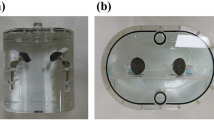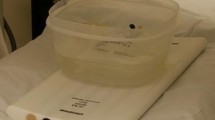Abstract
CT beam hardening artifacts near metal hip implants may erroneously enhance or diminish radiotracer uptake following CT attenuation correction (AC) of PET images. An artifact reduction algorithm (ARA) was developed to reduce metal artifacts in CT-based AC-PET. The algorithm employed a Bayes classifier to identify beam-hardening artifacts, followed by a partial correction of the attenuation map. ARA was implemented on phantom and patient 18F-FDG studies using a clinical PET/CT scanner. In phantom studies ARA successfully removed two artifacts of erroneously elevated uptake near a stainless steel hip prosthesis which were depicted in the standard CT-AC PET. ARA has also identified two targets absent on the scanner PET images. Target-to-background ratios were 1.5–3 times higher for ARA-PET than scanner images. In a patient study, metal artifacts were of lower intensity in ARA-PET as compared to standard images. Potentially, ARA may improve detectability of small lesions located near metal hip implants.










Similar content being viewed by others
References
Bar-Shalom R, Guralnik L, Tsalic M, Leiderman M, Frenkel A, Gaitini D, Ben-Nun A, Keidar Z, Israel O (2005) The additional value of PET/CT over PET in FDG imaging of oesophageal cancer. Eur J Nucl Med Mol Imaging 32(8):918–924
Bar-Shalom R, Yefremov N, Guralnik L, Gaitini D, Frenkel A, Kuten A et al (2003) Clinical performance of PET/CT in evaluation of cancer: additional value for diagnostic imaging and patient management. J Nucl Med 44(8):1200–1209
Beyer T., Townsend D.W., Brun T, Kinahan PE, Charron M, Roddy R et al (2000) A combined PET/CT scanner for clinical oncology. J Nucl Med 41(8):1369–1379
Bujenovic S, Mannting F, Chakrabarti R, Ladnier D (2003) Artifactual 2-deoxy-2-[(18)F]fluoro-D-glucose localization surrounding metallic objects in a PET/CT scanner using CT-based attenuation correction. Mol Imaging Biol 5(1):20–22
Burger C, Goerres G, Schoenes S, Buck A, Lonn AHR, von Schulthess GK (2002) PET attenuation coefficients from CT images: experimental evaluation of the transformation of CT into PET 511-keV attenuation coefficients. Eur J Nucl Med 29:922–927
Coleman RE (2002) Is quantitation necessary for oncological PET studies? For Eur J Nucl Med Mol Imaging 29(1):133–135
Connolly TJ (1978) Foundations of nuclear engineering. Wiley, New York, p 131
DiFilippo FP, Brunken RC (2005) Do implanted pacemaker leads and ICD leads cause metal-related artifact in cardiac PET/CT? J Nucl Med 46(3):436–443
Fukui MB, Blodgett TM, Meltzer CC (2003) PET/CT imaging in recurrent head and neck cancer. Semin Ultrasound CT MR 24(3):157–163
Gambhir SS, Czernin J, Schwimmer J, Silverman DHS, Coleman RE, Phelps ME (2001) A tabulated summary of the FDG PET literature. J Nucl Med 42:1S–93S
Goerres G, Hany T, Kamel E, von Schulthess GK, Buck A (2002) Head and neck imaging with PET and PET/CT: artifacts from dental metallic implants. Eur J Nucl Med 29:367–370
Gonzalez RC, Woods RE (2002) Digital image processing, 2nd edn. Prentice Hall, Upper Saddle River, p 699
Gonzalez RC, Woods RE (2002) Digital image processing, 2nd edn. Prentice Hall, Upper Saddle River, p 526
Graham MM (2002) Is quantitation necessary for oncological PET studies? Against. Eur J Nucl Med Mol Imaging 29(1):135–138
Hudson HM, Larkin RS (1994) Accelerated image reconstruction using ordered subsets of projection data. IEEE Trans Med Imag 13(4):601–609
Kak AC, Slaney M (2001) Principles of computerized tomographic imaging. SIAM, New York, pp 118–124
Kalender WA, Hebel R, Ebersberger JA (1987) Reduction of CT artifacts caused by metallic implants. Radiology 164:576–577
Kamel EM, Burger C, Buck A, von Schulthess GK, Goerres GW (2003) Impact of metallic dental implants on CT-based attenuation correction in a combined PET/CT scanner. Eur Radiol 13(4):724–728
Kamel E, Hany TF, Burger C, Treyer V, Lonn AHR, von Schulthess GK, Buck A (2002) CT vs 68Ge attenuation correction in a combined PET/CT system: evaluation of the effect of lowering the CT tube current. Eur J of Nucl Med 29:246–350
Keidar Z, Militianu D, Melamed E, Bar-Shalom R, Israel O (2005) The diabetic foot: initial experience with 18F-FDG PET/CT. J Nucl Med 46(3):444–449
Kinahan PE, Townsend DW, Beyer T, Sashin D (1998) Attenuation correction for a combined PET/CT scanner. Med Phys 25:2046–2053
Lonn AHR (2003) Evaluation of method to minimize the effect of X-ray contrast in PET-CT attenuation correction. IEEE Nucl Sci Symp Conf Rec 3:2220–2221
Mawlawi O, Erasmus JJ, Pan T, Cody DD, Campbell R, Lonn AH, Kohlmyer S, Macapinlac HA, Podoloff DA (2006) Truncation artifact on PET/CT: impact on measurements of activity concentration and assessment of a correction algorithm. Am J Roentgenol 186(5):1458–1467
Nuyts J, Stroobants S (2005) Reduction of attenuation correction artifacts in PET-CT. Conf Rec of the 2005 IEEE Nuc Sci Symp 4:1895–1899
Ollinger JM, Fessler JA (1997) Positron-Emission Tomography. IEEE Trans Sig Proc 14:43–55
Robertson DD, Yuan J, Wang G, Vannier MW (1997) Total hip prosthesis metal-artifact suppression using iterative deblurring reconstruction. J Comput Assist Tomogr 21:293–298
Tarantola G, Zito F, Gerundini P (2003) PET instrumentation and reconstruction algorithms in whole-body applications. J Nucl Med 44(5):756–769
Wang G, Snyder DL, O’Sullivan JA, Vannier MW (1996) Iterative deblurring for CT metal artifact reduction. IEEE Trans Med Imag 15:657– 664
Watson CC, Rappoport V, Faul D, Townsend DW, Carney JP (2006) A method for calibrating the CT-based attenuation correction of PET in human tissue. IEEE Trans Nucl Sci 53(1):102–107
Yazdia M, Gingras L, Beaulieu L (2005) An adaptive approach to metal artifact reduction in helical computed tomography for radiation therapy treatment planning: experimental and clinical studies. Int J Radiat Oncol Biol Phys 62(4):1224–1231
Zhao S, Robertson DD, Wang G, Whiting B, Bae KT (2000) X-ray CT metal artifact reduction using wavelets: An application for imaging total hip prostheses. IEEE Trans Med Imaging 19:1238–1247
Author information
Authors and Affiliations
Corresponding author
Rights and permissions
About this article
Cite this article
Kennedy, J.A., Israel, O., Frenkel, A. et al. The reduction of artifacts due to metal hip implants in CT-attenuation corrected PET images from hybrid PET/CT scanners. Med Bio Eng Comput 45, 553–562 (2007). https://doi.org/10.1007/s11517-007-0188-8
Received:
Accepted:
Published:
Issue Date:
DOI: https://doi.org/10.1007/s11517-007-0188-8




